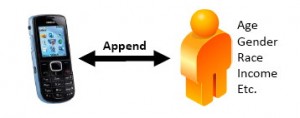Hitting The Target With Bulzī
Gail Chiasson, North American Editor
Newport Beach, California-based Bulzī Media Inc., a digital media company that has built an addressable advertising network for the digital signage industry, has now unveiled its LOCALīz audience measurement platform, a system that provides anonymized (ie non-personally identifiable information) real-time audience measurement for groups of consumers in out-of-home environments.
 Bulzī uses LOCALīz to power micro-targeted ad delivery on digital signage networks operated by Bulzī affiliates.
Bulzī uses LOCALīz to power micro-targeted ad delivery on digital signage networks operated by Bulzī affiliates.
Bulzī’s LOCALīz platform continually measures the ever-changing small-group audiences near a digital sign or billboard, along with the demographic profile and segmentation composition of the group. Real-time micro-audiences identified by LOCALīz provide a new and highly credible way to measure out-of-home audiences, allowing Bulzī to target ads to tens of consumers rather than tens of millions.
We had a long discussion last night with Roy Reeves, Bulzī vice-president media networks and partnerships, who explained how this works in considerable detail. Similarly to the way a television cable network might supply an ad to one house but not another because of the audience demographics, or that homes in a certain neighbourhood might receive a direct mail piece because of the demographics, Bulzī with its LOCALīz platform can deliver ads to digital screens based on the audience nearby (ie geofencing).
 But it is not just to any group of consumers. The ads are determined because of knowledge of the cell phones of those consumers. A group of teenage boys in the vicinity of a screen would receive a totally different ad than, says a group of career women in the 25-34 age group.
But it is not just to any group of consumers. The ads are determined because of knowledge of the cell phones of those consumers. A group of teenage boys in the vicinity of a screen would receive a totally different ad than, says a group of career women in the 25-34 age group.
So rather than an advertiser learning after the fact about who saw his ad via facial recognition and other survey data, the advertiser can now target his ads knowing that those nearby in his specific target group probably saw ads specifically targeting them. Bulzī doesn’t know the specific details of the owners of the mobile phones, but knows certain demographic information such as age, gender, ethnicity and 10 other criteria.
“We have arrangements with a demographics firm as well as with various local service carriers and mobile application providers, so we know certain general information, and can tell from the mobile phone pings when people with these demographics are near a specific screen,” says Reeves.
To generate the micro-audience profiles, LOCALīz leverages more than 20 billion anonymized mobile phone location records every day of the small groups exposed to each ad on each digital sign. Billions of micro-audience ‘small group profiles’ are generated based solely on the non-personally identifiable information, and then scored against ad campaign requirements in real-time by Bulzī’s ad platform.
When a ‘match’ is found, Bulzī delivers the right message to the right micro-audience, at the right place and time. Bulzī management says that this audience scoring and ad delivery platform gives advertisers a 10x to 100x improvement in their ability to reach their targeted audiences on digital signage networks.
“We can go to networks sort of like an aggregator and offer to help sell unused inventory, and can go to an advertiser, learn what he is looking for as a target audience. His ads would then run on the screens specifically whenever his target group is nearby,” says Reeves. He says that the company has already made arrangements with some as yet unrevealed networks. He is also as yet unable to name the demographics company or carriers, but says that Bulzī has been developing the system for more than two years and testing it in field trials with top digital signage network operators in 2011. It is now going public, preparing for commercial launch in early 2012. and the company will likely be demonstrating it by the time Digital Signage Expo rolls around in March.
Bulzī sees it as facilitating efficient cross-channel media campaign deployment and direct-measured effective reach metrics.
“For the last several years companies have used anonymized mobile phone location records to report traffic flow in real time to applications such as Google Maps,” says Brent McKay, Bulzī’s CEO. “Bulzī’s LOCALīz platform adds another layer of intelligence, allowing advertisers to efficiently reach targeted micro-audiences in out-of-home environments. LOCALīz builds micro-audiences using 100% anonymized data with zero personally identifiable information. Because out-of-home advertising is a one-to-many medium, we are able to identify micro-audiences and serve ads accordingly without specific knowledge of any one individual.
“This capability brings a new level of efficiency and scalability to the digital signage advertising industry, which is already one of the fastest growing media channels. It also brings the out-of-home industry into direct alignment with targeted advertising trends in other digital media.”
Bulzī plans to expand its affiliate network to include over 400,000 out-of-home screens across the U.S. by mid-2012, with the aim of reaching over 100 million unique monthly visitors.
Bulzī is a privately-owned company. It has been offering Signzī, a network software system using video technology, for several years. McKay is the visionary behind development of the new products.

Follow DailyDOOH